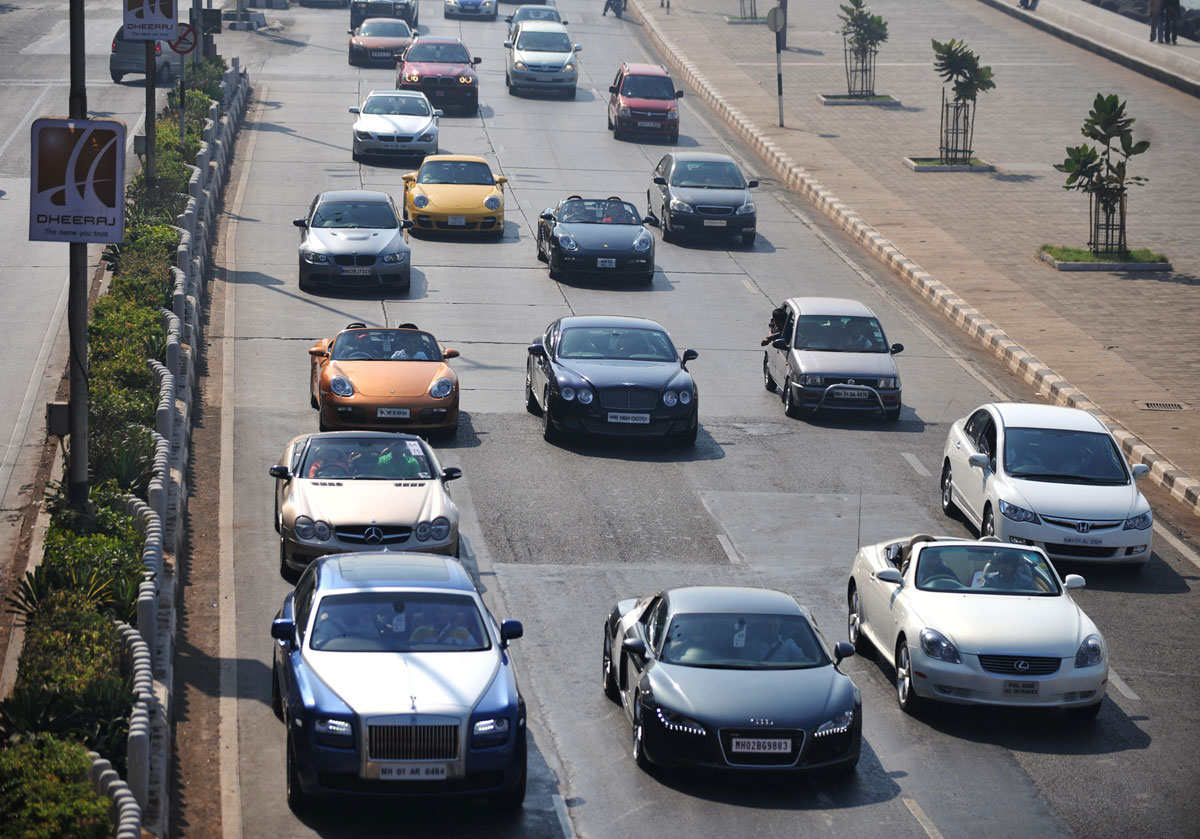India’s Obsession with Speed that Kills
Sports car enthusiasts drive their cars in the streets of Mumbai. Fast cars like the above are becoming a cause for concern as their speed and agility is often misunderstood by many Indian drivers, and many reckless driving and speed-related accidents take place, specially in the country’s capital, New Delhi. (Sajjad Hussain/AFP/Getty Images)
Over the recent weeks, a series of crashes that have involved recklessly driven vehicles on Delhi roads, have been disquieting. Two of the crashes have involved rashly driven BMW’s and one an Audi. Five people have died. These instances add to the several other accidents due to rash driving, writes Siddharth Srivastava. – @Siliconeer #Siliconeer #roadrage #IndianRoads #newdelhi #fastcarsinIndia #youth #underagedrivers #Audi #BMW #Mercedes #Maruti #Porsche #LandRover #Jaguar #Lamborghini
In April last year, CCTV footage of an out-of-control Mercedes Benz, driven by a juvenile, mowing down a young man crossing the road, made for horrible viewing.
Indian roads and traffic conditions are not equipped to handle speed. So are many behind the wheels of powerful engines that have hit the Indian market, including Porsche, BMW, Jaguar Land Rover, Audi, Lamborghini and more. Anybody who has driven these cars knows that the machines require skilled handling as they can accelerate to very high speeds within few seconds.
Their in-built stability and cruise features makes the driving smooth at very high velocities unlike some of the lower end cars that rattle like a train compartment when the speedometer crosses eighty. This also means that an inexperienced person driving a BMW, could very well be lulled into believing that he or she is moving at a pace that is much less than the actual speed. The dangerous part is that, relatively, the Audi or a Mercedes could be cruising much faster than the rest of the traffic, a recipe for disaster for anybody, those that follow rules and others who do not.
All indicators point towards even more robust machines hitting Indian roads. Bigger and more powerful cars have become the bellwether for upward economic mobility, with cricket and Bollywood stars at the forefront of endorsing and riding very expensive vehicles. In keeping with the distorted ethos, indulgent rich parents hand over the remote car keys to their imprudent and often unhinged kids who rocket about crowded streets, as if they are playing a virtual video game on their PSP, secure in the safety net of airbags, inept judicial process and daddy’s money.
Inevitably, minors and drunk drivers continue to wreak havoc on the roads without a care. A rashly driven auto rickshaw or a bike can cause damage, even kill. However, an impetuously driven high-end heavyweight luxury car, is a disaster waiting to happen. Unfortunately, the mitigating measures so far are just not enough: the laws are lax, traffic management inadequate, PCR vans and autos double up as ambulances in the absence of medical emergency services, while driving licenses are issued without proper vetting. Expressways that cut across villages and towns of India, without accompanying food overbridges, have added to the disaster quotient. Horrible accidents are reported on the Gurgaon Expressway, the DND Flyway that connects Delhi to Noida, the Yamuna Expressway to Agra, every week, due to absence of effective countermeasures. Given the abysmal state of public transport, more and more vehicles are going to continue to hit Indian roads.
All of this makes Indian roads the most dangerous in the world with 150,000 fatalities every year, exponentially more than the number of people who die due to terrorism, border skirmishes with Pakistan or Maoist violence that afflicts a vast swathe or central and eastern India. Ironically, India’s obsession with speed continues unabated beyond just the roads, without adequate safeguards in place. The Modi government, for example, is rooting for faster and faster trains without taking necessary measures to upgrade safety. Train coaches are outdated due to which a collision or derailment causes many more deaths and injuries; signaling and track systems of the Indian Railways continue to be archaic, while unmanned crossings need to be plugged urgently.
Four major derailments have happened in the recent past, including the Indore-Patna Express tragedy in November in which 151 passengers died, one of the most disastrous crashes ever; 41 died after the Hirakhand Express derailed last month. Many more have been crippled for life. New Delhi has floated conspiracy theories including sabotage by the Maoist and role of the ISI.
The culpability, however, lies with successive Rail ministers over the years who have treated the Indian Railways as a fief to further their political agendas.
India needs to check its obsession with speed without requisite pre-emptive measures to arrest the enormous and relentless human massacre.


